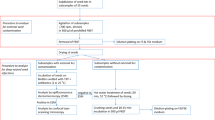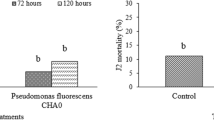Abstract
Teleutospores ofPuccinia punctiformis were used for germination and inoculation experiments. The percentage of germination increased with increasing root extract concentration separately from the spore-suspension present in the same Petri dish.
Volatile substances in root extracts of the thistle plant markedly promoted the germination of the teleutospores.
Inoculation experiments showed that underground parts of plants ofC. arvense can be infected. The percentage of diseased shoots emerging from inoculated root segments was higher than of those emerging from seeds. Three types of systemically infected shoots could be distinguished.
The development of spermogonia on the diseased shoots indicates that at first the hyphae are haploid, but later on become dikaryotic as shown by the formation of uredosori. Teleutospores are thus responsible for the systemic infection of the plants.
Samenvatting
Teleutosporen vanPuccinia punctiformis zijn gebruikt voor kiemings- en incubatieproeven.
Vluchtige substanties, aanwezig in wortelextracten van de akkerdistel, hebben een grote invloed op de kieming van teleutosporen. Het percentage kiemende teleutosporen nam toe bij toenemende concentraties van het wortelextract, aanwezig in dezelfde petrischaal als de sporensuspensie.
Inoculatieproeven toonden aan dat ondergrondse plantedelen vanC. arvense kunnen worden geïnfecteerd. Het percentage aangetaste scheuten opkomend uit wortelsegmenten was groter dan dat van scheuten verkregen uit zaden. Behalve systemisch geïnfecteerde scheuten werden ook enkele lokaal geïnfecteerde scheuten aangetroffen. De systemisch geïnfecteerde planten konden worden onderscheiden in drie verschillende types.
De ontwikkeling van spermogonia op de systemisch aangetaste scheuten wijst er op dat het aanwezige mycelium haploid is, zoals ook te verwachten is bij infecties met basidiosporen. Pas later worden de hyphen dikaryotisch, zoals blijkt uit de vorming van uredosori.
Similar content being viewed by others
References
Anonymus, 1978. De akkerdistel, beschouwd vanuit landbouw, natuur en landschap. Nationale Raad voor Landbouwkundig Onderzoek, Wageningen.
Buller, A., 1950. Researches on fungi. VII: 344–388. Hafner, New York.
French, R.C. & Turner, S.K., 1984. Identification of teliospore-germination stimulators in Canada Thistle roots. Phytopathology 74: 565.
Haggar, R.J., Oswald, A.K. & Richardson, W.G., 1986. A review of the impact and control of creeping thistle (Cirsium arvense L.) in grassland. Crop Protection 5: 73–76.
Menzies, B., 1953. Studies on the systemic fungusPuccinia suaveolens. Annals of Botany New Series XVII 68: 551–568.
Moore, R.J., 1975. The biology of Canadian weeds: 13.Cirsium arvense (L.) Scop. Canadian Journal of Plant Science 55: 1033–1048.
Müller, F., 1976. Translokation von14C-markiertem MCPA in verschiedenen Entwicklungsstadien mehrjähriger Unkräuter. Parey, Berlin/Hamburg.
Özer, Z., 1969. Untersuchungen zur Biologie und Bekämpfung der Ackerkratzdistel,Cirsium arvense (L.) Scop. Diss. Univ. Hohenheim.
Turner, S.K., Kwiatkowski, A. & Fay, P.K., 1982. Stimulation ofPuccinia obtegens teliospore germination. Phytopathology 72: 711.
Author information
Authors and Affiliations
Rights and permissions
About this article
Cite this article
Van Den Ende, G., Frantzen, J. & Timmers, T. Teleutospores as origin of systemic infection of Cirsium arvense by Puccinia punctiformis. Netherlands Journal of Plant Pathology 93, 233–239 (1987). https://doi.org/10.1007/BF01998251
Accepted:
Issue Date:
DOI: https://doi.org/10.1007/BF01998251




